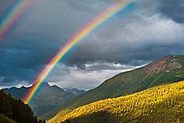06.04.2016 | News
Water availability in the Northern Hemisphere has seen much larger changes during the past twelve centuries than during twentieth century global warming, a new study in Nature reports.

The researchers from Sweden, Germany, and Switzerland have for the first time reconstructed the variations in water availability across the Northern Hemisphere seamless for the past twelve centuries. This allows for comparisons between various parts of Europe, Asia, and North America.
The study shows that hydroclimate extremes have been stronger and covered larger areas in some earlier centuries than during the twentieth century, explains lead author Fredrik Charpentier Ljungqvist from Stockholm University.
Water availability through the centuries
The researchers reconstructed changes in water availability – the hydroclimate – by statistically analysing evidence for changes in precipitation and drought, such as varying lake levels, soil humidity or river runoff. To do this the researchers compiled hundreds of records from various climate archives across the Northern Hemisphere: tree-rings, speleothems, lake sediments, and written historical records.
The scientists compared their reconstructed hydroclimate variations with a new temperature reconstruction they also developed, to understand links between the two. It turned out that only a few regions showed clear correlations between changes in temperature and hydroclimate. For instance, drought was most widespread during both the relatively warm twelfth century and the relatively cold fifteenth century.
Test for climate models
According to Ljungqvist, the study shows the importance of a millennium-long perspective on hydroclimate changes. Meteorological measurements of precipitation and drought date back at most a few centuries – too short to tell if today’s changes fall outside the range of natural variability. “They are also too short to test if climate models are correct when predicting that drier regions get drier and wetter regions get wetter with global warming”, says Ljungqvist.
Both the new temperature reconstruction and the climate model simulations agree that the twentieth century likely was the warmest in at least the past millennium. "But unlike the climate models our reconstruction does not show any dramatic increase in hydroclimate extremes", says Ljungqvist.
"The current models seem to simulate precipitation characteristics well over the pre-industrial period, but do not appear to capture as well the more recent anthropogenically driven changes in the climate system," explaines co-author David Frank from WSL. More research is needed to find out why, he says.
This does not necessarily mean the mechanisms driving hydroclimate changes in climate models are wrong, points out Ljungqvist. "It could be that the global warming is not yet strong enough to trigger the changes in precipitation patterns that climate models simulate". The authors conclude that while the reconstructions based on climate archive data also have their uncertainties, they are still a very valuable tool to test models used to predict future changes in water availability.
Copyright ¶
Contact ¶
Dr. phil. Fredrik C. Ljungqvist
University of Stockholm
fredrik.c.l@historia.su.se
Mobile phone: +4670-662 07 28
Links and documents ¶
Original publication:
Fredrik Charpentier Ljungqvist, Paul J. Krusic, Hanna S. Sundqvist, Eduardo Zorita, Gudrun Brattström & David Frank: "Northern Hemisphere hydroclimate variability over the past twelve centuries", Nature, vol. 532, pp. 94–98, doi:10.1038/nature17418
